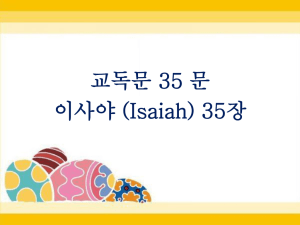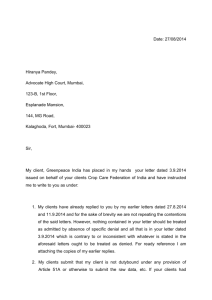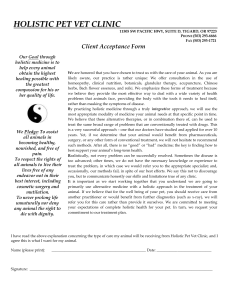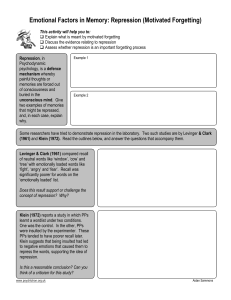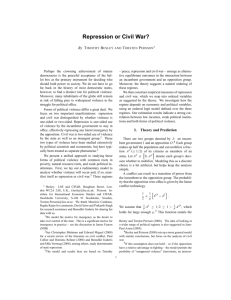LMT I (Consciousness-based medicine)
advertisement
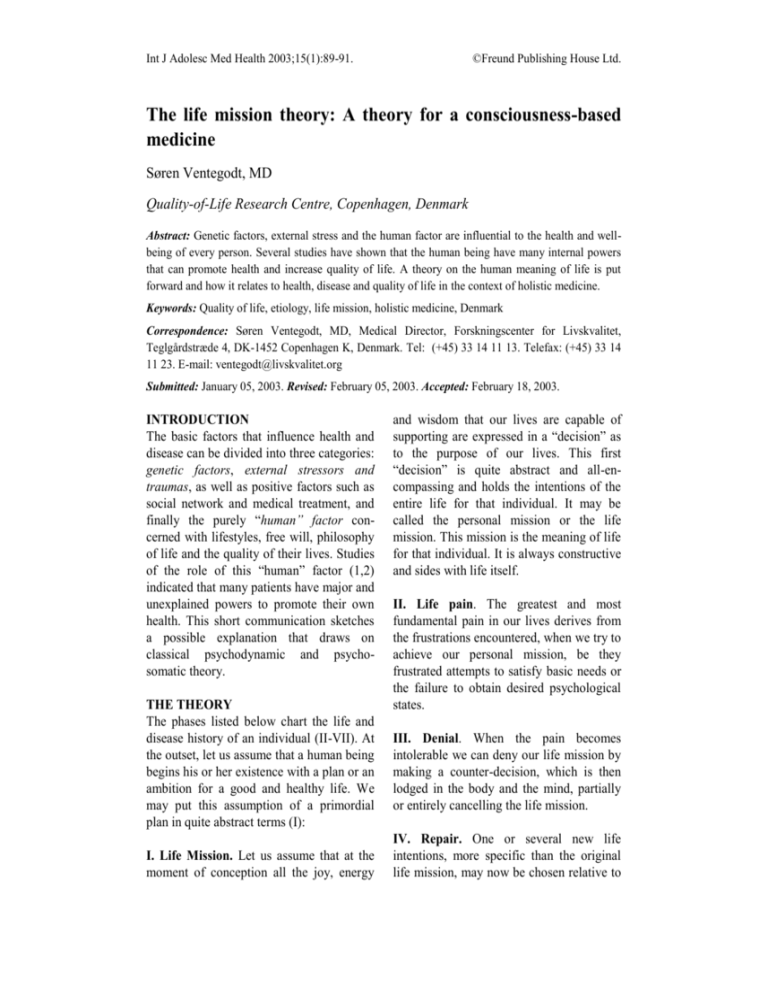
Int J Adolesc Med Health 2003;15(1):89-91. ©Freund Publishing House Ltd. The life mission theory: A theory for a consciousness-based medicine Søren Ventegodt, MD Quality-of-Life Research Centre, Copenhagen, Denmark Abstract: Genetic factors, external stress and the human factor are influential to the health and wellbeing of every person. Several studies have shown that the human being have many internal powers that can promote health and increase quality of life. A theory on the human meaning of life is put forward and how it relates to health, disease and quality of life in the context of holistic medicine. Keywords: Quality of life, etiology, life mission, holistic medicine, Denmark Correspondence: Søren Ventegodt, MD, Medical Director, Forskningscenter for Livskvalitet, Teglgårdstræde 4, DK-1452 Copenhagen K, Denmark. Tel: (+45) 33 14 11 13. Telefax: (+45) 33 14 11 23. E-mail: ventegodt@livskvalitet.org Submitted: January 05, 2003. Revised: February 05, 2003. Accepted: February 18, 2003. INTRODUCTION The basic factors that influence health and disease can be divided into three categories: genetic factors, external stressors and traumas, as well as positive factors such as social network and medical treatment, and finally the purely “human” factor concerned with lifestyles, free will, philosophy of life and the quality of their lives. Studies of the role of this “human” factor (1,2) indicated that many patients have major and unexplained powers to promote their own health. This short communication sketches a possible explanation that draws on classical psychodynamic and psychosomatic theory. THE THEORY The phases listed below chart the life and disease history of an individual (II-VII). At the outset, let us assume that a human being begins his or her existence with a plan or an ambition for a good and healthy life. We may put this assumption of a primordial plan in quite abstract terms (I): I. Life Mission. Let us assume that at the moment of conception all the joy, energy and wisdom that our lives are capable of supporting are expressed in a “decision” as to the purpose of our lives. This first “decision” is quite abstract and all-encompassing and holds the intentions of the entire life for that individual. It may be called the personal mission or the life mission. This mission is the meaning of life for that individual. It is always constructive and sides with life itself. II. Life pain. The greatest and most fundamental pain in our lives derives from the frustrations encountered, when we try to achieve our personal mission, be they frustrated attempts to satisfy basic needs or the failure to obtain desired psychological states. III. Denial. When the pain becomes intolerable we can deny our life mission by making a counter-decision, which is then lodged in the body and the mind, partially or entirely cancelling the life mission. IV. Repair. One or several new life intentions, more specific than the original life mission, may now be chosen relative to 2 THE LIFE MISSION THEORY what is possible henceforth. They replace the original life mission and enable the person to move forward again. They can, in turn, be modified, when they encounter new pains experienced as unbearable. (Example: Mission #1: “I am good.” Denial #1: “I am not good enough.” Mission #2: “I will become good,” which implies I am not). V. Repression and loss of responsibility. The new life intention, which corresponds to a new perspective on life at a lower level of responsibility, is based on an effective repression of both the old life mission and the counter-decision that antagonises and denies it. Such a repression causes the person to split in a conscious and one or more unconscious/subconscious parts. The end result is that we deny and repress parts of ourselves. Our new life intention must always be consistent with what is left undenied. VI. Loss of physical health. Human consciousness is coupled to the wholeness of the organism through the information systems that bind all the cells of the body into a unity. Disturbances in consciousness may thus disturb the organism's information systems, resulting in the cells being less perfectly informed as to what they are to do where. Disruptions in the necessary flow of information to the cells of the organism and tissues hamper the ability of the cells to function properly. Loss of cellular functionality may eventually result in disease and suffering. VII. Loss of quality of life and mental health. In psychological and spiritual terms, people who deny their personal mission gradually lose their fundamental sense that life has meaning, direction and coherence. They may find that their joy of life, energy to do important things and intuitive wisdom are slowly petering out. The quality of their lives is diminished and their mental health impaired. IIX. Loss of functionality. When we decide against our life mission we invalidate our very existence. This shows up as reduced self-worth and selfconfidence. Thus, the counter-decisions compromise not only our health and quality of life, but also our basic powers to function physically, psychologically, socially, at work, sexually, etc. APPLYING THE THEORY Spiegel et al (1) asked women with metastatic breast cancer to talk to each other in group sessions about their illness. As described in the article, the women made an effort to improve the quality of their lives. Survival improved radically, relative to a control group. This may be accounted for as follows. When people confront and deal with still more of their destructive cognitions or attitudes to life, then the counter-decisions recorded in their bodies and minds results in the repressed pain to resurface in consciousness to be dealt with and the fragmentation of the person slowly ceases. We heal and we become whole. Since the fragmentation is one of the causes of the disease resulting in decreased quality of life and ability to function, the internal repair will enable the person to become more healthy, happy and functional. The inner qualities of joy, energy and wisdom re-express themselves. Other things being equal, there will be prophylactic effects on new outbreaks of disease, accidents and loss of functionality. Ornish et al (2) induced patients with coronary arteries severely constricted from atherosclerosis to adopt lifestyle changes and deal with the quality of their lives. This had beneficial effects on the arterial constrictions, as compared with a control group. The life mission theory may explain this S. VENTEGODT by reference to the systematic efforts exerted by the patients to modify their behaviours and the attitudes that go along with them. This means that people work to relinquish destructive attitudes to life that deny the life mission. As this denial recedes, the person more or less returns to his or her natural state of health, quality of life and ability to function. The theory predicts that, for example, that when a person is helped along by a family physician conducting a conversation (clinical interview or consultation) about the quality of life of that person, she can reestablish her life mission. The person can then recognize it as the proper purpose in her life. She can rearrange her life accordingly and achieve her truest sense of humanity, a human being in full agreement with herself and life. This person can draw on her resources and potentials to the fullest 3 degree. In her natural state, a human being is maximally valuable to herself and the world around her. A consciousness-oriented (holistic) medicine based on this theory will help people become valuable not only to themselves, but also to each other. REFERENCES 1. Spiegel D, Bloom JR, Kraemer HC, Gottheil E. Effect of psychosocial treatment on survival of patients with metastatic breast cancer. Lancet 1989; 2(8668):888-91. 2. Ornish D, Brown SE, Scherwitz LW, Billings JH, Armstrong WR, Ports TA, Kirkeeide RL, Brand RJ, Gould KL. Can lifestyle changes reverse coronary heart disease? The Lifestyle Heart Trial. Lancet 1990;336(8708):129-33.



